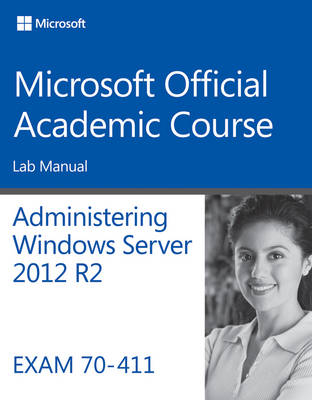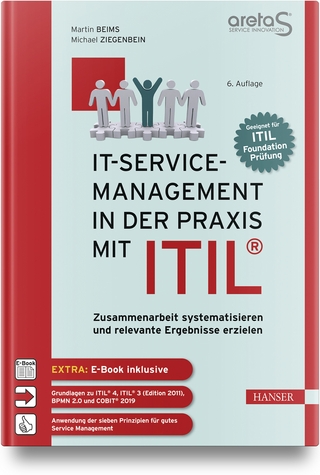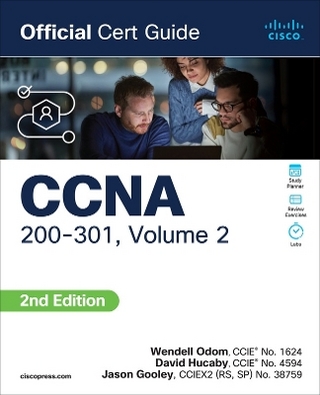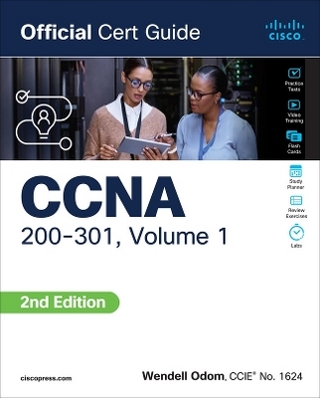
70–411 Administering Windows Server 2012 R2 Lab Manual
John Wiley & Sons Inc (Verlag)
978-1-118-88291-7 (ISBN)
- Titel ist leider vergriffen;
keine Neuauflage - Artikel merken
This is the print lab manual adjacent to the 70-411
Administering Windows Server 2012 R2 textbook. 70-411
Administering Windows Server 2012 R2 covers the second of three
exams required for Microsoft Certified Solutions Associate (MCSA):
Windows Server 2012 certification. This course validates the
skills and knowledge necessary to administer a Windows Server 2012
Infrastructure in an enterprise environment. The three MCSA exams
collectively validate the skills and knowledge necessary for
implementing, managing, maintaining, and provisioning services and
infrastructure in a Windows Server 2012 environment. This Microsoft
Official Academic Course is mapped to the 70-411 Administering
Windows Server 2012 exam skills, including the recent R2
objectives. This textbook/lab manual focuses on real skills for
real jobs and prepares students to prove mastery of core services
such as user and group management, network access, and data
security. In addition, this book also covers such valuable skills
as:
Implementing a Group Policy Infrastructure
Managing User and Service Accounts
Maintaining Active Directory Domain Services
Configuring and Troubleshooting DNS
Configuring and Troubleshooting Remote Access
Installing, Configuring, and Troubleshooting the Network Policy
Server Role
Optimizing File Services
Increasing File System Security
Implementing Update Management
The MOAC IT Professional series is the Official from Microsoft,
turn-key Workforce training program that leads to professional
certification and was authored for college instructors and college
students. MOAC gets instructors ready to teach and students ready
for work by delivering essential resources in 5 key areas:
Instructor readiness, student software, student assessment,
instruction resources, and learning validation. With the Microsoft
Official Academic course program, you are getting instructional
support from Microsoft; materials that are accurate and make course
delivery easy.
The Microsoft Official Academic Course (MOAC) Program is the official product for Microsoft Programs in higher education. These learning products are created especially for the academic market and combine the business world focus and market research of Microsoft with 200 years of successful higher education publishing from Wiley. The program is based upon the same curriculum as the Microsoft IT Certifications to build the skills students need to succeed at work and the preparation they need to validate those skills and get the jobs they seek. All the support instructors need to deliver great courses on Microsoft software is in the program. Student copies of the textbooks include the trial software in select markets and student files for completing homework assignments. Microsoft Updates will bring you the latest information on new products and curriculums and are a part of the program. MOAC is a great way for instructors to get ready to teach and for students to get ready for work.
1. Deploying and Managing Server Images 1
Exercise 1.1: Installing and Configuring Windows Deployment Services 3
Exercise 1.2: Creating Windows Deployment Images 4
Exercise 1.3: Generating an Autounattend.xml file 7
Exercise 1.4: Deploying a Windows Image 13
Exercise 1.5: Updating a Windows Image 15
Lab Challenge: Adding Drivers to a Windows Image 17
2. Implementing Patch Management 19
Exercise 2.1: Installing WSUS 20
Exercise 2.2: Configuring WSUS 23
Exercise 2.3: Configuring Clients 26
Exercise 2.4: Approving Updates 28
Lab Challenge: Running WSUS Reports 30
3. Monitoring Servers 31
Exercise 3.1: Using Event Viewer 32
Exercise 3.2: Using Reliability Monitor 39
Exercise 3.3: Using Task Manager 41
Exercise 3.4: Using Resource Monitor 44
Exercise 3.5: Using Performance Monitor 45
Exercise 3.6: Monitoring VMs 48
Lab Challenge: Using Network Monitor 50
4. Configuring Distributed File System (DFS) 51
Exercise 4.1: Installing DFS 52
Exercise 4.2: Configuring DFS Namespace 53
Exercise 4.3: Configuring DFS Replication 57
Lab Challenge: Creating a Fault-Tolerant Shared Folder 60
5. Configuring File Server Resource Manager 61
Exercise 5.1: Installing File Server Resource Manager 62
Exercise 5.2: Configuring Quotas 63
Exercise 5.3: Managing Files with File Screening 65
Exercise 5.4: Using Storage Reports 69
Exercise 5.5: Configuring File Management Tasks 70
Lab Challenge: Enabling SMTP for FSRM 71
6. Configuring File Services and Disk Encryption 73
Exercise 6.1: Encrypting Files with EFS 74
Exercise 6.2: Configuring the EFS Recovery Agent 79
Exercise 6.3: Backing Up and Restoring EFS Certificates 83
Exercise 6.4: Encrypting a Volume with BitLocker 85
Lab Challenge: Deploying Network Unlock 88
7. Configuring Advanced Audit Policies 89
Exercise 7.1: Implementing Auditing 90
Exercise 7.2: Implementing Advanced Auditing 93
Exercise 7.3: Using AuditPol.exe 95
Lab Challenge: Auditing Removable Devices 97
8. Configuring DNS Zones 99
Exercise 8.1: Installing DNS 101
Exercise 8.2: Creating Primary and Secondary Zones 102
Exercise 8.3: Creating an Active Directory Integrated Zone 105
Exercise 8.4: Configuring Zone Delegation 106
Exercise 8.5: Configuring a Stub Zone 108
Exercise 8.6: Configuring Forwarding and Conditional Forwarding Zones 109
Exercise 8.7: Configuring Zone Transfers 111
Lab Challenge: Using the DNSCMD Command to Manage Zones 112
9. Configuring DNS Records 113
Exercise 9.1: Managing DNS Resource Records 114
Exercise 9.2: Configuring Round Robin 118
Exercise 9.3: Configuring Zone Scavenging 119
Exercise 9.4: Troubleshooting DNS 121
Lab Challenge: Using the DNSCMD Command to Manage Resource Records 123
10. Configuring VPN and Routing 125
Exercise 10.1: Installing and Configuring RRAs 126
Exercise 10.2: Configuring a VPN Server 128
Exercise 10.3: Configuring a VPN Client 131
Exercise 10.4: Configuring Split Tunneling 135
Exercise 10.5: Configuring Routing 136
Exercise 10.6: Resetting Servers 139
Lab Challenge: Using the Route Command 140
11. Configuring DirectAccess 141
Exercise 11.1: Implementing Client Configuration 142
Exercise 11.2: Implementing DirectAccess Server 145
Exercise 11.3: Implementing the Infrastructure Servers 145
Exercise 11.4: Implementing the Application Servers 146
Exercise 11.5: Resetting Servers 147
Lab Challenge: Configuring Certificates for DirectAccess 148
12. Configuring a Network Policy Server 149
Exercise 12.1: Installing and Configuring Network Policy Server 150
Exercise 12.2: Configuring NPS for RADIUS Server for VPN Connections 153
Exercise 12.3: Managing RADIUS Templates 154
Exercise 12.4: Configuring RADIUS Accounting 155
Lab Challenge: Add Workstation Authentication Certificates to All Workstations 157
13. Configuring NPS Policies 159
Exercise 13.1: Creating and Configuring Connection Request Policies 160
Exercise 13.2: Creating and Configuring Network Policies 163
Exercise 13.3: Exporting and Importing the NPS Configuration 165
Lab Challenge: Processing Network Policies 166
14. Configuring Network Access Protection (NAP) 167
Exercise 14.1: Installing Health Registration Authority Role on an NPS Server 168
Exercise 14.2: Configuring NAP Enforcement for DHCP 170
Exercise 14.3: Configuring SHV and Health Policies 173
Lab Challenge: Configuring Clients for NAP 175
15. Configuring Server Authentication 177
Exercise 15.1: Creating a Service Account 178
Exercise 15.2: Creating a Managed Service Account 179
Exercise 15.3: Using virtual account 182
Exercise 15.4: Configuring Kerberos and Kerberos Delegation 183
Lab Challenge: Configuring Kerberos with the Setspn Command 185
16. Configuring Domain Controllers 187
Exercise 16.1: Promoting Server01 to a Domain Controller 188
Exercise 16.2: Configuring Universal Group Membership Caching 189
Exercise 16.3: Moving Operations Masters 191
Exercise 16.4: Seizing Operations Masters 194
Exercise 16.5: Creating an RODC 195
Lab Challenge: Cloning a Domain Controller 198
17. Maintaining Active Directory 199
Exercise 17.1: Backing Up System State 200
Exercise 17.2: Restoring the System State 203
Exercise 17.3: Using an Active Directory Snapshot 205
Exercise 17.4: Restoring a Deleted Object Using the Active Directory Recycle Bin 208
Exercise 17.5: Managing the Active Directory Database 210
Lab Challenge: Removing Server02 from Active Directory 212
18. Configuring Account Policies 213
Exercise 18.1: Configuring a Domain Password Policy 214
Exercise 18.2: Configuring Account Lockout Settings 216
Exercise 18.3: Configuring a Password Settings Object 217
Exercise 18.4: Configuring Kerberos Policy Settings 220
Lab Challenge: Managing Password Settings Objects Permissions 222
19. Configuring Group Policy Processing 223
Exercise 19.1: Configuring Processing and Precedence of GPOs 224
Exercise 19.2: Configuring Blocking Inheritance and Enforced Policies 226
Exercise 19.3: Configuring Security Filtering and WMI Filtering 228
Exercise 19.4: Configuring Loopback Processing 230
Lab Challenge: Using Group Policy Results Wizard 231
20. Configuring Group Policy Settings 233
Exercise 20.1: Performing Software Installation with Group Policies 234
Exercise 20.2: Using Folder Redirection 237
Exercise 20.3: Using Scripts with Group Policies 239
Exercise 20.4: Using Administrative Templates 241
Exercise 20.5: Using Security Templates 243
Lab Challenge: Using ADM Files 245
21. Managing Group Policy Objects 247
Exercise 21.1: Backing Up and Restoring GPO 248
Exercise 21.2: Importing and Copying GPOs 250
Exercise 21.3: Resetting Default GPOs 252
Exercise 21.4: Delegating Group Policy Management 252
Lab Challenge: Using a Migration Table 254
22. Configuring Group Policy Preferences 255
Exercise 22.1: Configuring Printer Settings 256
Exercise 22.2: Configuring Network Drive Mappings 259
Exercise 22.3: Configuring Power Options 259
Exercise 22.4: Configuring Internet Explorer (IE) Settings 261
Exercise 22.5: Performing File, Folder, and Shortcut Deployment 263
Lab Challenge: Configuring Item-Level Targeting 264
| Erscheint lt. Verlag | 19.8.2014 |
|---|---|
| Verlagsort | New York |
| Sprache | englisch |
| Maße | 217 x 275 mm |
| Gewicht | 642 g |
| Themenwelt | Informatik ► Weitere Themen ► Zertifizierung |
| Sozialwissenschaften ► Pädagogik | |
| ISBN-10 | 1-118-88291-1 / 1118882911 |
| ISBN-13 | 978-1-118-88291-7 / 9781118882917 |
| Zustand | Neuware |
| Informationen gemäß Produktsicherheitsverordnung (GPSR) | |
| Haben Sie eine Frage zum Produkt? |
aus dem Bereich


